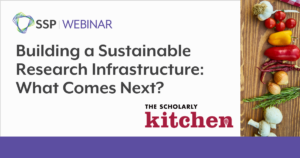 The 3rd SSP webinar of 2020 delved into scholarly and research infrastructure on Tuesday, April 21. Panelists were asked about the meaning of “sustainable open infrastructure,” as the webinar sought to update the viewer on the current state of the research infrastructure as it looked ahead to what needs to be done to ensure that it meets the future needs of all stakeholders across all disciplines and regions.
The 3rd SSP webinar of 2020 delved into scholarly and research infrastructure on Tuesday, April 21. Panelists were asked about the meaning of “sustainable open infrastructure,” as the webinar sought to update the viewer on the current state of the research infrastructure as it looked ahead to what needs to be done to ensure that it meets the future needs of all stakeholders across all disciplines and regions.
The event began with moderator Alice Meadows (Director of Community Engagement, NISO) introducing the panel and the idea of sustainable open infrastructure. Alice then asked audience members to submit their own descriptions of sustainable open infrastructure, which populated into a live word cloud. Audience submissions included words like reproducible, persistent, flexible, and sturdy.
As the first panelist, Liz Allen (Director of Strategic Initiatives, F1000) attempted to define what we mean by “scholarly infrastructure.” Liz proposed that scholarly infrastructure should be able to:
- Increase discoverability and usability
- Reduce administrative burden
- Reduce fragmentation
- Benefit research and research impact
- Provide measurable ROI
In short, scholarly infrastructure should be the foundation of an effective research system.
Liz felt that ORCID and Crossref are working well as infrastructure components, but they do not cover everything needed in our research system. To build future infrastructure elements we will need more cross-sector dialogue and harmonization around specific requirements to broaden the usefulness of the infrastructure we build.
Liz concluded with the point that prioritization is key: “If you try to solve everything, you’ll get nowhere.”
Phill Jones (Owner, Principal Consultant, Double L Digital) began by describing the ideal value chain for scholarly works, and then quickly noted how our fragmented infrastructures mean many valuable pieces of the scholarly journey (ideas, grants, data, posters, publications) are not connected or interoperable. Our lack of good infrastructure, especially the lack of persistent identifiers (or their uptake), means answering questions about research as a whole is very hard. Good infrastructure would allow content to be connected to indexes, and for those connections to be persistent and allow cross-referencing.
If Phill had one wish, it would be the creation of a set of well-governed, well-adopted, interoperable persistent identifiers (PIDs) with appropriate metadata, specifically starting with an institutional identifier.
Gabi Mejias (Engagement Lead, Europe, ORCID) highlighted the many benefits of ORCID, and how it operates as a valuable piece of the infrastructure puzzle. ORCID meets many of the requirements discussed by the other panelists, including:
- Open operation – the software is open source, and data is openly released.
- Community ownership and institutional participation and investment.
- Interoperable with other identifiers, and has a member API. Can link to DOIs, Arkiv IDs, and PubMed IDs.
- Community includes researchers and organizations that build information management systems.
- Covers a diverse set of content.
Taken together, ORCID may offer a template for the development and adoption of other infrastructure standards.
In her concluding thoughts, Gabi had a wish similar to Phill’s, which is to have more machine-readable PIDs used by our communities.
Karin Wulf (Professor of History, College of William and Mary and Director, Omohundro Institute) applied her background in history to think beyond STEM when considering scholarly infrastructure. Research workflows in the humanities tends to look quite different from STEM fields, in that humanists communicate knowledge in ways that are not captured in a PID. Humanists exchange a great deal of information via conferences and seminars, meaning the publication is only one small part of the scholarly journey. Humanists must often retrofit existing infrastructure to fit their needs.
Karin made the point that good infrastructure scales small as well as large, and it should be flexible enough to fit diverse use cases. ORCID is great because it begins with the user, rather than an organization, which allows it to cover a greater range of outputs, including now conference content.
Collectively, the panelists promoted the use of PIDs as an important infrastructure solution. They also supported using PIDs for outputs beyond the stereotypical journal article to more fully encompass the scope of scientific and scholarly work. Building a sustainable open infrastructure is possible. We have taken the first steps, but there is more work to be done.
Watch the webinar in our library now!
News contribution by SSP member, Michael Casp. Michael is the Director of Business Development at J&J Editorial.



Join the Conversation
You must be logged in to post a comment.